Wall blocks made of different materials are used for the construction of vertical enclosing structures for industrial and residential buildings. Blocks for building a house come with different secondary materials in the form of filler, but they are based on cement, sand, water, clay. Wall stones are made with a corrugated or even surface, they are dyed with pigments during production or left without color.
Varieties of blocks for building a house
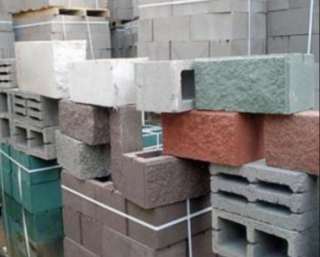
Building products for the construction of walls have a volumetric weight that is in the range of 1.8 - 2.0 t / m³. The filler is cellular, organic and porous substances - so manufacturers reduce the load on the foundation and increase the protection of the interior of the building from cold. According to their size, they are conventionally divided into large-sized and small-sized products.
Materials and substances are used in the manufacture of:
- Portland cement gray, colored and white;
- quartz sand;
- crushed stone and gravel of different sizes (5 - 20 mm);
- water;
- expanded polystyrene and polyvinyl chloride granules;
- fiberglass fibers;
- iron rods A-1, A-3, B-1 and BP-2;
- organic and artificial pigments.
By design, blocks for the house are rough, front on one or two sides. Heat-insulating products are distinguished as a separate category. Structurally, they are released hollow and corpulent. The first type is characterized by low weight, cost, low conductivity of thermal energy. Through holes of various shapes are used for the device of hidden reinforcement or laying of communications.
Gas silicate
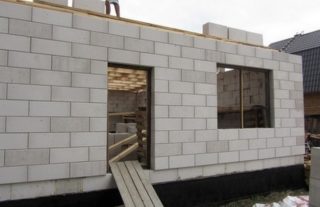
The material is a type of porous material, the basis is a mixture of crushed sand, lime, water. For manufacturing, the mass is placed in molds without filling to the top, and a gas-forming component is introduced. The process takes place under pressure, communicating bubbles form in the mass, and the stone hardens. Allowed to be added to the gas silicate of crushed slag, ash, lime, gypsum.
Aerated concrete blocks have precise geometric dimensions. The density is regulated by the amount of the gas generator; several brands are produced depending on the strength and heat-insulating properties.
Gas silicate blocks have positive qualities:
- the lightness of the walls of the material leads to a reduction in the cost of the foundation, which saves money;
- low heat conductivity reduces the cost of heating the building;
- a wide range for choosing the required quality of aerated concrete;
- clear geometry and large dimensions reduce mortar consumption and labor costs;
- easy processing (sawing, drilling, chipping);
- incombustibility.
Blocks are divided according to their purpose into structural, heat-insulating and structural-heat insulating. The raw material is hardened in an autoclave under pressure, under the action of electric heaters, saturated steam or in the natural environment. As a binder, they take boiling lime, cement, Portland cement, slag and ash varieties.
Slag concrete
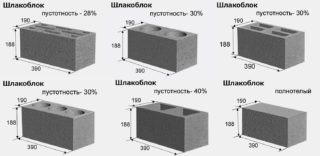
The material is obtained by analogy with concrete, but instead of crushed stone, waste from the heat treatment of raw materials is used in the production of building materials.An alloy of oxides (slag) is taken from production without the use of chemicals, before use, it is kept in air for natural cleaning from lime and sulfur inclusions.
The blocks include slag of size in the form of sand (to increase the density), crushed stone (to reduce the mass). Finished block stones have good performance characteristics, which are combined with an acceptable cost.
The following brands of cinder blocks are produced:
- M10 is used as an insulation cladding;
- M25, M35 - used for internal (non-bearing) walls and partitions between rooms;
- M50 and more are used for the construction of load-bearing walls and columns.
The advantages of slag concrete are its lightness compared to natural stone or solid brick. The dimensions allow the building to be built in a relatively short time.
Colored stones are produced for the construction of the original facade, they are dyed in bulk with the help of organic pigments. Varieties of stones with chipped and ragged surfaces are used for decorative cladding.
Foam concrete
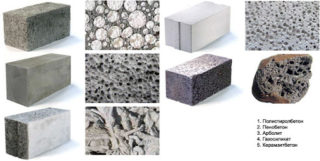
Blocks made of this material are referred to as cellular products with appropriate qualities. Sand, cement and foaming agent are involved in the production. It is introduced into the solution to swell the mass and obtain a structure with closed pores inside. The ready-made mixture for solidification is poured into molds or blocks are cut out from the solidified mass. The material is not subjected to heat treatment. Strength gain lasts 28 days.
Positive qualities of aerated concrete:
- foam concrete blocks do not get wet from water, since air bubbles are isolated from neighboring cells;
- due to low hygroscopicity, products do not crack in the cold;
- foam concrete does not conduct heat well, therefore it serves as a good insulator;
- lightness makes it possible to reduce the cost of building the supporting foundation of the building.
Foam concrete blocks for walls are produced with the addition of an artificial or organic foam former. If you choose a synthetic blowing agent, the blocks will be cheaper, but of poor quality. As a result of the use of protein foam formers, stronger blocks are obtained due to the thick walls between the pores.
Reinforcement of the first row of foam is required and then a metal rod is laid every 4 rows. At the top, a monolithic reinforced concrete belt is made under the ends of the floor slabs.
Expanded clay
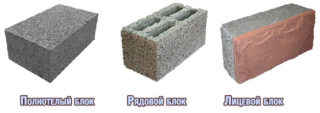
In production, expanded clay crushed stone, chips and air-entraining modifiers are used as concrete filler. In the first case, lighter stones with a lower density are obtained, and in the second, the compactness is higher and the weight of the blocks increases. More often, for the construction of a house, products with a density of 0.5 - 1.8 t / m³ are taken from blocks for permanent residence.
Advantages of using expanded clay concrete:
- houses of this type are not subject to shrinkage, deformation, cracks;
- low cost of wall material due to the availability of raw materials and simple technology;
- strength, durability.
The production of blocks from expanded clay concrete does not require large investments, therefore there are many offers from handicraft manufacturers in the construction market. Such products do not meet standard standards, therefore, when buying a product, you need to make sure of the performer's reputation.
Arbolitovye
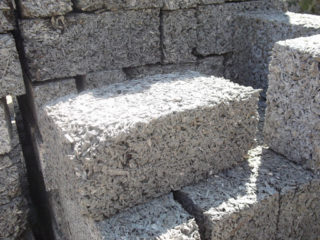
Wall elements for masonry are 80% composed of waste wood, sand, cement, water and chemical additives. Before using the sawdust, the shavings are dried to stop the various processes in the organic filler. Arbolite is produced in the form of panels, plates and solutions for monolithic areas.
High-density materials are placed in the structure of the walls, and stones of a loose structure are used in the form of insulation.Many woodworking companies began to produce wood concrete blocks, but they do not always follow the technology, therefore, when buying, they pay attention to the manufacturer.
The advantages of wood concrete:
- warm material maintains a cozy microclimate;
- does not emit harmful substances when heated, does not burn;
- small weight of stones;
- easy to saw, drilled;
- low-rise buildings are built without reinforcement, and for two-story buildings, steel rods with a diameter of 8 mm or more are used;
- increased bending strength, good noise absorption.
A wall made of such blocks is notable for its unsightly appearance, therefore, external and internal decoration is mandatory. The masonry is carried out using a cement-sand mortar, after every three rows, they give time to dry.
The use of a special masonry mixture with increased thermal protection has proven itself well in order to exclude cold bridges.
Ceramic
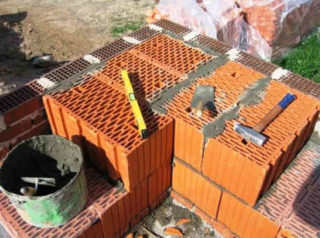
Blocks are used for the construction of multi-storey buildings, the construction of internal walls and partitions of simple and complex shapes. The ceramic surface does not require waterproofing, has a beautiful appearance without cladding, therefore, it saves money by excluding additional building materials from the construction cycle.
Ceramic blocks are divided into 2 types, depending on the constituent components:
- porous;
- unporised.
The first category contains foam waste, clay, cellulose. Minor impurities burn out during firing, and the smallest pores appear in the structure, increasing the heat-insulating qualities of the stones. The non-porous material does not include any modifiers, therefore, the blocks are distinguished by a greater mass, strength, but let heat pass.
Both types have high performance of sound insulation, environmentally friendly. Masonry is carried out by simple methods, standard dimensions do not imply the selection of elements for installation, therefore, the construction of walls is accelerated. Special glue is purchased, the thickness of which in the seam of the masonry is 2 - 4 mm. High-rise buildings involve reinforcement of the seams with a fiberglass mesh.
Polymer
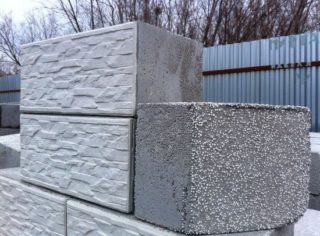
Blocks are recently used in construction. Stones are made in production or in home workshops. For the mixture, they take cement, water, sand, polymer granules, additives to accelerate hardening. The components are mixed in a mortar mixer, then the mixture is filled into molds. The mass is grasped for about a day, then the finished stones are removed and laid out for drying in natural conditions.
Varieties are produced:
- with a lined surface on one side in the form of marble, granite is used for finishing the facade of buildings;
- without cladding are used for ordinary masonry walls.
The cost of polystyrene blocks is about 2 times lower than the price of a brick for a wall of similar parameters. The material has low heat conductivity, good sound insulation. They are durable, frost-resistant, do not emit harmful substances into the surrounding atmosphere.
Sizes and selection rules
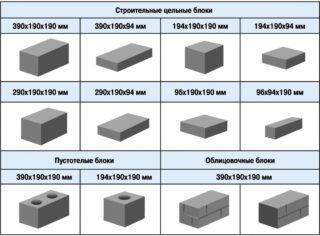
State standards standardize the dimensional parameters of blocks for masonry. Standardization helps to make the correct volume count of the material. The list provides for solid stones or blocks with holes for communications.
Dimensions of wall elements:
- expanded clay concrete stones, solid and hollow - 40x20x20 cm;
- gas silicate - 60x25x40 cm and 60x25x50 cm;
- foam concrete - 60x30x25 cm and 60x40x20 cm;
- polystyrene - 60x30x25 cm and 40x20x20 cm;
- wood concrete - 15x20x50 cm, 20x20x50 cm and 30x20x50 cm;
- ceramic - 25x12x6.5 cm, 25x12x14 cm, 25x25x14 cm, 51x9.5x22 cm.
When choosing materials, their cost and thermal conductivity, as well as labor costs for the construction of vertical structures, are taken into account. They take into account the need for insulation, waterproofing and decorative finishes, which will entail costs.What matters is the strength and bearing characteristics of the finished wall, its fire hazard, moisture saturation and environmental friendliness.
Disadvantages of materials
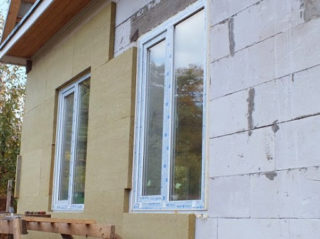
The disadvantages of gas silicate are manifested in the fact that the cells inside communicate with each other, therefore, the blocks are saturated with water in conditions of high humidity, with rain. Fences require an additional waterproofing layer, which is placed outside, therefore, external wall decoration is required.
The disadvantages of the cinder block include an uneven surface, which increases the volume of the solution, for example, in comparison with aerated concrete stones. The curing process takes about a month during production.
The disadvantages of expanded clay are that the wall requires an external insulation layer with subsequent decorative finishing. Expanded clay belongs to the category of porous materials that absorb and hold water inside. The storage conditions of stones matter, it is better to store them under a canopy.
The negative qualities of polystyrene stones appear if the production technology is violated. Deviations from the rules lead to microcracks, shrinkage. When kneading, binder fibers must be added to increase strength.
Arbolite has low moisture resistance, absorbs up to 40 - 80% of the liquid, therefore, external waterproofing is done, and for internal walls, atmospheric humidity is maintained up to 75%.
The ceramic block is classified as an expensive type, while the fragility of the elements is noted. Transport on pallets to avoid battle. Ceramics cannot be split with a brick-like pickax; you need to use a grinder.
The advantage of blocks over bricks and wood
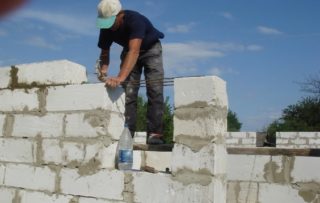
The large dimensions of the elements speed up the laying process, even with the installation of reinforcement. The low weight also makes erection easier. Small-sized bricks require more labor and more frequent checking of the horizontal and verticality of the wall. Massive brick fences are placed on the foundation of great depth. The skeleton of a building made of blocks will be much cheaper than building a brick.
The timber in the wall structure and glued lumber are pretreated with various impregnations to protect the tree from fire, dampness and the action of microorganisms, bugs. Concrete-based wall blocks do not have such difficulties; they can be installed immediately after purchase.








